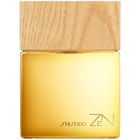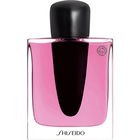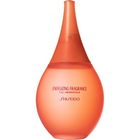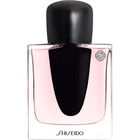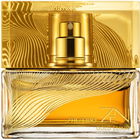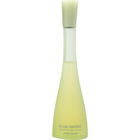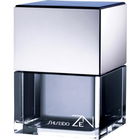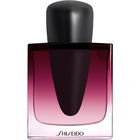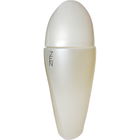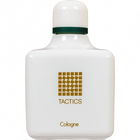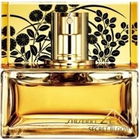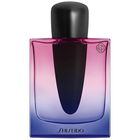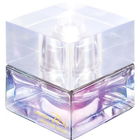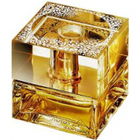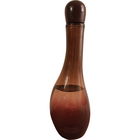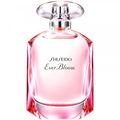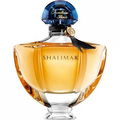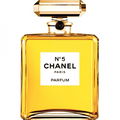Thirty years ago, Féminité du Bois was released, not with the fanfare typically celebrated at that time, including 70 mm campaigns, but with a purple-mauve advertising motif, featuring a small asymmetrical, organically shaped bottle in similar color shades, around which a paper band meandered, seemingly set in motion moments before by an unclothed female figure. Below it was written, distributed with an acrobatics of tabulator spaces and the typographical balancing act of a stretched Shiseido 'S':
SHISEIDO
HAUTE
PARFUMERIE
DES ESSENCES PURES
ET IDENTIFIABLES
SHISEIDO PARFUM
FÉMINITÉ DU BOIS
CONÇU PAR LES SALONS DU PALAIS ROYAL SHISEIDO PARIS
JARDINS DU PALAIS ROYAL, PARIS 1ER
At that time, Serge Lutens had already been responsible for the photography and art direction of the advertisements for the Japanese cosmetics giant Shiseido, founded in 1872, for 12 years. Féminité du Bois was the second perfume Lutens conceived for the house after Nombre Noir (1982), and although the presentation was quiet compared to Chanel, Dior & Co., the fragrance turned some things in perfumery upside down, as only happens every 20 - 30 years. Féminité du Bois was often mentioned whenever the question arose about which perfume a brand would have liked to release itself, or what the aha experience was that led someone to dedicate themselves professionally to perfume. Shiseido - a true cosmetics specialist - focused on tactility. Féminité Du Bois was released in different concentrations and formats, all of which had various but somehow complementary forms; in addition to perfume and Eau de Parfum, there was the lighter 'shy' Eau Timide, a 3-piece set of Parfum Stylo's, a kind of roll-on stick in perfume concentration, a Too Heavenly Body Cream, lotion, deodorant - the full program. The corresponding packaging was designed in variations of the purple-mauve color spectrum, in a textured cardboard with a wood pattern. At the same time, Shiseido opened Les Salons du Palais Royal Shiseido in Paris; a house-owned cosmetics salon, but more so as a holistic staging of Shiseido's and Lutens' master plan of a 'total environment'. Here, I must concede to Luca Turin that he aptly diagnosed this function; especially in the 90s, the Paris boutique offered an exquisite yet otherworldly shopping experience: the place, the light, the bell-shaped bottles. Until around 1999/2000, Lutens' name was not visible on the labels; similar to the advertisement for Féminité du Bois, these merely stated LES SALONS DU PALAIS ROYAL SHISEIDO PARIS.
While Lutens' work with Shiseido goes back to '79/80, he mentioned around 2009/2010, at the time when the perfume transitioned from Shiseido to the now-established brand 'Serge Lutens', that it was a moment with a piece of cedar wood, 1968 in Marrakech, that ultimately sparked the initial idea for a cedar-centered fragrance. That Cèdre, a kind of late, coded feedback to Féminité du Bois, would only follow in 2005 perhaps shows how formative this encounter was, but even more so, how central this material would become for Lutens.
In 1992, Féminité du Bois appeared more or less as a solitary fragrance; no other scent had so directly and sensually refined a woody note, interwoven with quasi-culinary notes of North African cuisine, used entirely un-gourmand, ginger, cumin, dried fruits, along with waxy and honey-like elements, a novelty. Féminité du Bois was neither an antithesis to L’Eau d’Issey (1992) and the increasing aquatization and de-pitting that spread rapidly during those years, nor in line with the highly effective flavor that Angel (also 1992) was to embody. The perfume felt massive, solid, and light, almost transparent; although a plum note had been mixed in with oriental hits of the 70s and 80s, it was only at Féminité du Bois that it was so deliciously on point. Perhaps due to the combination of cumin and cedar wood, Féminité du Bois appears particularly 'settled', oscillating between historical furniture, interiors, moods, and all that a composed perfume with oriental subtitles entails; a watershed moment compared to much that had been established in the decades before. Chanel's Bois des Îles (1927) was at that time, if at all, only available directly from Chanel; the inspired Egoiste (1990) paved my instant acceptance of Féminité du Bois just as much as Alberto Morilla's wonderful early work Romeo Giglio Uomo (1991), with its plum + wood note.
The Internet Archive contains many reports like this one about Féminité du Bois, with fictional and concrete elements gradually coming to light or being re-tangled. In an interview with the Parisian Nez magazine, Lutens mentioned in 2019 that all the perfumers in the running were housed at the La Mamounia Hotel in Marrakech, and he additionally had bowls with shavings of Atlas cedar placed. This wood from the Atlas and Rif mountains, on the Red List since 2013, an important material in North African sacred and palace buildings for centuries, was perhaps more the spark in the Moroccan context, as a concrete material - for Féminité du Bois, ultimately, Texas cedarwood oil was used at 8% (see: Ohloff, G., Pickenhagen, W. and Kraft, D.P., 2012. Scent and chemistry: the molecular world of odors. Weinheim.) None of the invited perfumers initially succeeded in replicating Lutens' cedar reference, but Christopher Sheldrake's design apparently was the most fitting, although the cedar quality desired by Sheldrake was not yet available; Pierre Bourdon took over (according to Lutens 2019 - earlier reviews consistently mention the order as Bourdon first, and then Sheldrake), Maurice Roucel may have also advised - what that means remains unclear. That Féminité du Bois is said to consist of more than 50% of a woody note has also leaked, that it is a study object for the use of Iso E Super with 43%, a precursor to the overdosage scents of this chemical, which emphasizes the cedarwood note again, is also noted, but it seems to me that this 'what else' here is composed more differentiated than in the flood of woody fragrances that have appeared since Féminité du Bois, especially from 2000 onwards.
…






 Cedarwood
Cedarwood Clove
Clove Cinnamon
Cinnamon Plum
Plum Sandalwood
Sandalwood Beeswax
Beeswax Cardamom
Cardamom Honey
Honey Musk
Musk Orange blossom
Orange blossom Peach
Peach Rose
Rose Violet
Violet


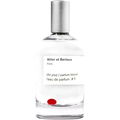



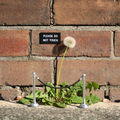






 Lillibet
Lillibet Rossiniopera
Rossiniopera Bcars10
Bcars10 Licorice
Licorice Unchaned
Unchaned Skydiver19
Skydiver19 Duftessa
Duftessa Flakon11e
Flakon11e Gold
Gold Kajsa5
Kajsa5